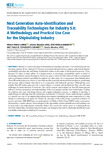Mostrar o rexistro simple do ítem
Next Generation Auto-Identification and Traceability Technologies for Industry 5.0: A Methodology and Practical Use Case for the Shipbuilding Industry
| dc.contributor.author | Fraga-Lamas, Paula | |
| dc.contributor.author | Varela-Barbeito, José | |
| dc.contributor.author | Fernández-Caramés, Tiago M. | |
| dc.date.accessioned | 2022-01-13T18:42:05Z | |
| dc.date.available | 2022-01-13T18:42:05Z | |
| dc.date.issued | 2021 | |
| dc.identifier.citation | P. Fraga-Lamas, J. Varela-Barbeito and T. M. Fernández-Caramés, "Next Generation Auto-Identification and Traceability Technologies for Industry 5.0: A Methodology and Practical Use Case for the Shipbuilding Industry," in IEEE Access, vol. 9, pp. 140700-140730, 2021, doi: 10.1109/ACCESS.2021.3119775. | es_ES |
| dc.identifier.uri | http://hdl.handle.net/2183/29379 | |
| dc.description.abstract | [Abstract] Industry 5.0 follows the steps of the Industry 4.0 paradigm and seeks for revolutionizing the way industries operate. In fact, Industry 5.0 focuses on research and innovation to support industrial production sustainability and place the well-being of industrial workers at the center of the production process. Thus, Industry 5.0 relies on three pillars: it is human-centric, it encourages sustainability and it is aimed at developing resilience against disruptions. Such core aspects cannot be fully achieved without a transparent end-to-end human-centered traceability throughout the value chain. As a consequence, Auto-Identification (Auto-ID) technologies play a key role, since they are able to provide automated item recognition, positioning and tracking without human intervention or in cooperation with industrial operators. Although the most popular Auto-ID technologies provide a certain degree of security and productivity, there are still open challenges for future Industry 5.0 factories. This article analyzes and evaluates the Auto-ID landscape and delivers a holistic perspective and understanding of the most popular and the latest technologies, looking for solutions that cope with harsh, diverse and complex industrial scenarios. In addition, it describes a methodology for selecting Auto-ID technologies for Industry 5.0 factories. Such a methodology is applied to a specific use case of the shipbuilding industry that requires identifying the main components of a ship during its construction and repair. To validate the outcomes of the methodology, a practical evaluation of passive and active UHF RFID tags was performed in an Offshore Patrol Vessel (OPV) under construction, showing that a careful selection and evaluation of the tags enables product identification and tracking even in areas with a very high density of metallic objects. As a result, this article serves as a useful guide for industrial stakeholders, including future developers and managers that seek for deploying identification and traceability technologies in Industry 5.0 scenarios. | es_ES |
| dc.description.sponsorship | This work was supported in part by the Auto-Identication for Intelligent Products Research Line of the Navantia-Universidade da Coruña Joint Research Unit under Grant IN853B-2018/02, and in part by the Centro de Investigación de Galicia ``CITIC,'' funded by Xunta de Galicia and the European Union (European Regional Development Fund-Galicia 2014_2020 Program) under Grant ED431G 2019/01 | es_ES |
| dc.description.sponsorship | Xunta de Galicia; IN853B-2018/02 | es_ES |
| dc.description.sponsorship | Xunta de Galicia; ED431G 2019/01 | es_ES |
| dc.language.iso | eng | es_ES |
| dc.publisher | Institute of Electrical and Electronics Engineers Inc. | es_ES |
| dc.relation.uri | https://doi.org/10.1109/ACCESS.2021.3119775 | es_ES |
| dc.rights | Atribución 4.0 internacional | es_ES |
| dc.rights.uri | http://creativecommons.org/licenses/by/4.0/ | * |
| dc.subject | Auto-ID | es_ES |
| dc.subject | Traceability | es_ES |
| dc.subject | Industry 5.0 | es_ES |
| dc.subject | Industry 4.0 | es_ES |
| dc.subject | Shipbuilding | es_ES |
| dc.subject | Shipyard | es_ES |
| dc.subject | UHF RFID | es_ES |
| dc.title | Next Generation Auto-Identification and Traceability Technologies for Industry 5.0: A Methodology and Practical Use Case for the Shipbuilding Industry | es_ES |
| dc.type | info:eu-repo/semantics/article | es_ES |
| dc.rights.access | info:eu-repo/semantics/openAccess | es_ES |
| UDC.journalTitle | IEEE Access | es_ES |
| UDC.volume | 9 | es_ES |
| UDC.startPage | 140700 | es_ES |
| UDC.endPage | 140730 | es_ES |
| dc.identifier.doi | 10.1109/ACCESS.2021.3119775 |
Ficheiros no ítem
Este ítem aparece na(s) seguinte(s) colección(s)
-
GI-GTEC - Artigos [193]






